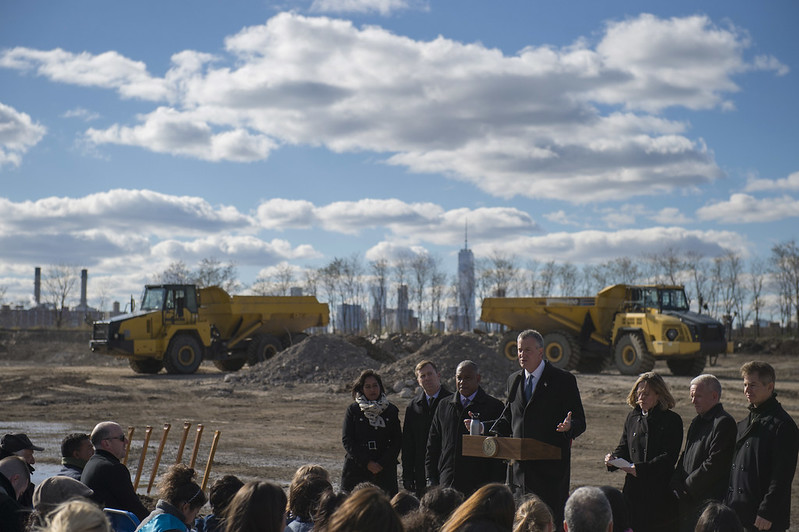
Mayor de Blasio makes a housing announcement (photo: Ed Reed/Mayor's Office)
In the wake of the economic devastation caused by the coronavirus shutdown, Mayor de Blasio must find budget savings anywhere he can, while still advancing his mission to make New York “the fairest big city” in America.
It won’t be easy. But the sudden drop in tax revenue should not stop the mayor from continuing to make one smart investment: creating new affordable housing.
With the pandemic exposing the full extent of the city’s homeless crisis, now is exactly the time to create more affordable and supportive housing, as well as high-quality shelter. Doing so can sharply reduce exorbitant spending on emergency homeless hotels, create good-paying jobs when we need them most, and end the terrible damage homelessness has inflicted on a generation of children.
New York City cannot afford to miss what is a once-in-a-lifetime opportunity.
Before the COVID-19 pandemic disrupted the city’s economy, the mayor found himself stuck in an unwinnable war against homelessness.
Mayor de Blasio created thousands of new, locally-funded rental vouchers for homeless families, helping many return to permanent housing. But the lowest rental housing vacancy rate in decades meant too many of the vouchers went unused, unable to counter the law of supply and demand.
The mayor also launched a record-breaking affordable housing production initiative that likewise helped thousands of homeless people find homes again. But with so many New Yorkers becoming homeless each night, the housing just couldn’t be built fast enough.
The pandemic has changed all this. And while the economic repercussions will be devastating, they also present a promising opportunity for change.
No matter what we do, New York City is likely losing residents now and into the immediate future. With the drop in demand, thousands of overleveraged properties will become available for purchase and conversion to affordable housing. With far fewer tourists visiting the city for the foreseeable future, newly superfluous hotels will be available for pennies on the dollar. Otherwise healthy apartment buildings will need formerly homeless tenants with rent vouchers those tenants can finally use.
With these new conditions suddenly in place, the mayor finally has the chance to lay the foundation for his successor to end widespread homelessness in New York City.
To do so, the city should first maintain – or even increase – capital investment in affordable housing production this year. The city borrows to fund this housing investment, so it has an outsized economic effect: the money creates housing (and jobs) today, but the bonds are paid back over decades. Fortunately, at this time interest rates are low, and the share of the city’s budget going toward borrowing costs is far below the 15% fiscal experts recommend as a cap. In short, we can afford to do this.
The administration has instead proposed slashing the capital housing budget by 40% — roughly half-a-billion dollars annually — this year and next. These cuts will delay the creation of thousands of new affordable housing units right when we need them most, and just as the cost of acquisition and development is falling.
Cutting half-a-billion dollars from the capital budget sounds like a lot of savings. But because the money for long-term investments like affordable housing is borrowed, the cut will only reduce the city’s cost of paying the money back — less than $50 million a year in savings. But in reality, we won’t save a thing. If these cuts go through, the next mayor will end up spending even more sheltering New Yorkers who remained homeless because the housing was never built.
Of course it’s not enough just to restore the cuts to affordable housing. Despite its newly straitened circumstances, the city should stick to the mayor’s original vision and keep providing rental vouchers to homeless households. It must redirect capital dollars to acquire newly available distressed properties. And it should build housing for the people who need it most: homeless, senior, and very poor New Yorkers, because housing vulnerable people has been proven, over and over again, to reduce public spending on health care, shelter, and other expensive emergency interventions.
Our city’s terrible homeless crisis demands a renewed commitment to creating more housing. Fortunately, few economic activities generate more benefits: such an effort will bring precisely the kinds of increased jobs and consumer spending we need right now to restore the city’s economy. It is the most effective and cost-efficient option available to the mayor to spur the city’s comeback. At the same time, no investment will do more to cement the mayor’s legacy of correcting long-standing systemic inequities that have plagued the city for decades.
***
Ted Houghton is the President of Gateway Housing, the former Executive Deputy Commissioner of New York State Homes and Community Renewal and former Executive Director of the Supportive Housing Network of New York. On Twitter @Gateway_Housing.
***
Have an op-ed idea or submission for Gotham Gazette? Email This email address is being protected from spambots. You need JavaScript enabled to view it.




